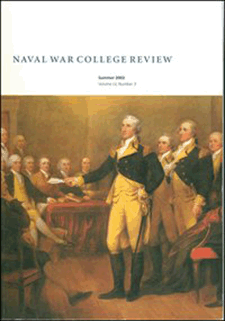Naval War College Review
Volume 55, Number 3 (2002) Summer
General George Washington Resigning His Commission (detail), by John Trumbull. This 1817 oil painting, which hangs today in the Rotunda of the U.S. Capitol, captures a momentous event that took place in the Maryland statehouse in Annapolis on 23 December 1783. Accompanied by two aides, George Washington, until that moment commander in chief of the victorious Continental Army, addresses members of the Continental Congress—identified by the Curator of the Capitol as including Thomas Mifflin (the president of the Congress, standing in the cover’s left foreground), Elbridge Gerry, Thomas Jefferson, and James Madison.
By returning to civilian life at that critical juncture, and thereby making it unmistakable that there would be no dictatorship, Washington laid the foundation for what would in 1787 become a central tenet of the Constitution and thereby of the republic—civilian control of the military. Today, however, argues Richard H. Kohn, one of the leading modern scholars of U.S. civil-military relations, in our lead article, that concept has been weakened by attitudes and expedients on both sides.
President's Forum
President's Forum
Rodney P. Rempt
Articles
Arcs of Instability
Geoffrey Kemp
The U.S. Military and the Evolving Challenges in the Middle East
Anthony H. Cordesman
Our Special Correspondent
Geoffrey Wawro
Book Reviews
Book Reviews
The U.S. Naval War College
The Great North Korean Famine:Famine, Politics, and Foreign Policy
Lyle J. Goldstein
Germs: Biological Weapons and America’s Secret
Christopher C. Harmon
Rickover: The Struggle for Excellence.
William S. Murray
We Come Unseen
Nigel West
Fleets of World War II
Frank Uhlig
200,000 Miles aboard the Destroyer
Christopher Bell
Waiting for Dead Men’s Shoes:Origins and Development of the U.S. Navy’s OfficerPersonnel System, 1793–1941
James Barber
The Island of Lost Maps: A True Story ofCartographic Crime
Xavier Maruyama
Additional Writing
Review Essay
Bruce Elleman


